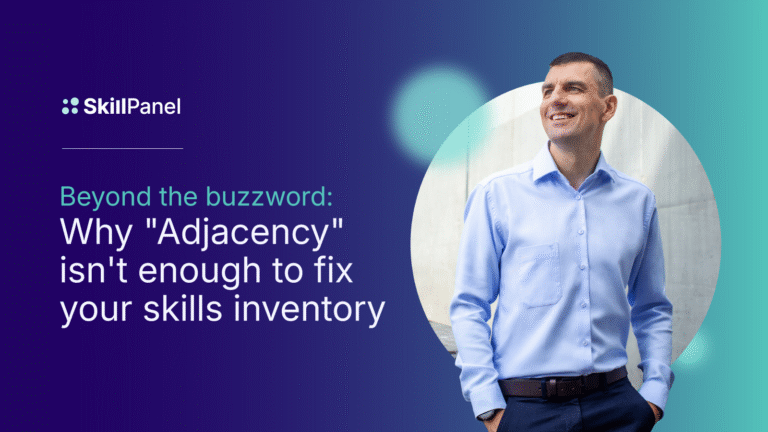
Data-driven HR: 2026 guide to transform your team
| Lesezeit:

The workplace has fundamentally shifted. What once relied on gut feelings and traditional approaches now demands precision, evidence, and strategic insight. Human resources stands at the forefront of this transformation, where data-driven methodologies are no longer optional—they’re essential for competitive advantage.
Modern organizations face unprecedented challenges: remote work complexities, skills shortages, and evolving employee expectations. Traditional HR approaches simply cannot address these realities effectively. The solution lies in embracing data-driven HR practices that transform how we attract, manage, and develop talent.
Understanding data-driven HR in the modern workplace
What is data-driven HR and why it matters in 2026
Data-driven HR represents a fundamental shift from intuition-based decisions to evidence-backed strategies. This approach harnesses employee data, analytics, and technology to make informed choices about hiring, retention, performance management, and organizational development. Rather than relying on assumptions or past practices, data driven human resources professionals now leverage concrete insights to guide their strategies.
The significance of this approach has never been more apparent. AI adoption among HR professionals surged to 72% in Q1 2025, up from 58% in Q1 2024, indicating rapid mainstreaming of data-driven HR practices. 75% of companies now use HR software for workforce management, emphasizing the baseline role of technology in modern HR operations.
Data-driven human resources encompasses every aspect of the employee lifecycle. From the initial talent acquisition process through onboarding, development, performance management, and retention, every touchpoint generates valuable data that can inform better decisions. This comprehensive approach ensures that HR strategies align with both employee needs and business objectives.
The impact is measurable and significant. HR analytics, when used strategically, boosts productivity by 25% and reduces attrition by 50%, demonstrating clear ROI from data-driven decision-making. These results reflect what industry leaders have observed: predictive analytics enables organizations to anticipate workforce needs rather than simply react to problems after they occur.
The evolution from intuition-based to evidence-based HR decisions
The traditional HR model relied heavily on subjective assessments, historical precedents, and personal experience. While these factors retain some value, they often led to inconsistent outcomes and missed opportunities. The evolution toward evidence-based practices represents a maturation of the HR profession, elevating it from an administrative function to a strategic business partner.
This transformation has been accelerated by technological advances and changing workforce dynamics. 96% of HR professionals report that AI improves talent acquisition and retention, validating measurable benefits across hiring and employee lifecycle management. Organizations now have access to unprecedented amounts of employee data, from performance metrics and engagement surveys to learning completion rates and career progression patterns.
Leading HR experts emphasize this shift toward predictive capabilities. As industry analysts note, “predictive analysis is most effective when it is a part of a comprehensive approach to data analysis”, encompassing descriptive, diagnostic, predictive, and prescriptive analytics to forecast needs and plan proactively for the future of work.
Evidence-based HR decisions demonstrate clear advantages over intuitive approaches. They reduce bias, improve consistency, and enable organizations to predict and prevent problems before they escalate. Most importantly, they allow HR professionals to measure their impact and continuously refine their strategies based on results.
Key differences between traditional HR and data-driven HR approaches
Traditional HR often operated reactively, addressing problems after they occurred. Data-driven HR enables proactive management, identifying potential issues through predictive analytics and trend analysis. 65% of leaders report significant increases in HR management productivity and efficiency from AI deployment, directly linking data-driven HR to organizational performance metrics.
The scope of decision-making also expands dramatically. Traditional approaches might consider limited factors when making hiring or promotion decisions. Data-driven approaches integrate multiple data sources, providing a comprehensive view of candidates or employees that leads to more informed choices.
Industry leaders recognize this transformation as fundamental. “Organizations are leveraging robust feedback mechanisms and sentiment analysis for real-time, nuanced insights into the employee experience”, enabling HR to continually realign strategies with actual employee needs rather than assumptions.
Accountability represents another crucial difference. Traditional HR struggled to demonstrate ROI and measure the impact of initiatives. Data driven results provide clear evidence of success or failure, enabling continuous improvement and strategic refinement. This transparency builds credibility with leadership and justifies HR investments.
The strategic benefits of data-driven HR for modern organizations
Enhanced decision-making through predictive analytics
Predictive analytics transforms HR from a reactive function to a strategic advisor. Rather than simply responding to employee departures or performance issues, HR teams can now identify patterns that predict these outcomes. This capability enables proactive interventions that prevent problems and optimize outcomes.
Real-world evidence demonstrates this impact. At Merck KGaA, the implementation of Visier’s people analytics platform integrating data from over 45 million points across their global business enabled around 3,500 users, including 3,000 line managers, to access real-time HR dashboards. The result was achievement of diversity targets, notably exceeding their 2021 goal of 30% female representation, alongside enhanced talent retention through predictive analytics that flagged first-year attrition risks.
HR specialists note that “people analytics provides detailed, individualized perspectives, enabling customized training and talent development”. This shift from generic programs to personalized interventions maximizes the impact of HR investments while improving employee satisfaction.
The power of predictive analytics extends beyond individual decisions to organizational planning. HR teams can forecast skills gaps, plan succession strategies, and allocate resources more effectively. This strategic capability positions HR as a critical partner in business planning and growth strategies.
Improved employee engagement and retention rates
Employee engagement directly impacts organizational performance, but measuring and improving it requires sophisticated approaches. Hr data strategy enables organizations to track engagement metrics in real-time, identify drivers of satisfaction or dissatisfaction, and implement targeted interventions.
The construction industry provides compelling evidence of this transformation. Kemp & Lauritzen faced rising employee turnover and inconsistent onboarding processes before deploying SAP SuccessFactors and developing a custom fast-hire app for field recruiting. The results were dramatic: employee turnover dropped from 35% to under 28%, voluntary exits reduced by one-third, and onboarding satisfaction ratings increased to 4.0 out of 5.
Modern engagement measurement goes beyond annual surveys to include pulse surveys, sentiment analysis, and behavioral indicators. Industry experts observe that “real-time data analysis empowers HR to tackle challenges as they emerge, enabling immediate interventions and reducing reliance on outdated annual review cycles”.
Retention strategies become significantly more effective when grounded in data. Rather than applying generic retention programs, organizations can identify specific risk factors and tailor interventions accordingly. This targeted approach maximizes impact while optimizing resource allocation.
Optimized workforce planning and resource allocation
Strategic workforce planning requires accurate predictions about future needs and capabilities. Hr metrics and workforce analytics enable organizations to model different scenarios, assess skills gaps, and plan development initiatives. This capability ensures that organizations maintain the right talent mix to achieve their strategic objectives.
The banking sector demonstrates the financial impact of optimized resource allocation. National Bank of Canada’s rollout of SAP SuccessFactors to automate payroll/time tracking resulted in immediate automation of 1,500 time-off requests on the first day and annual HR staffing and administrative savings of $4M. Management time spent on administration reduced by 5%, freeing leaders for strategic work.
Resource allocation becomes more precise when guided by data. Organizations can identify high-impact investments in training, technology, or benefits that deliver measurable results. This evidence-based approach to resource allocation maximizes return on investment and ensures sustainable growth.
The integration of workforce planning with business strategy creates a powerful competitive advantage. Organizations can align their talent strategies with market opportunities, ensuring they have the capabilities needed to capitalize on emerging trends.
Measurable ROI and performance outcomes
One of the most significant advantages of data-driven HR is the ability to demonstrate clear return on investment. Traditional HR initiatives often struggled to prove their value, making it difficult to secure resources and support. Data driven results provide concrete evidence of impact, building credibility and justifying continued investment.
Industry data reinforces these benefits across sectors. Employee turnover costs organizations up to 1-2 times an employee’s annual salary, making effective retention strategies crucial for financial performance. Data-driven approaches enable organizations to identify and address turnover drivers before they result in costly departures.
This measurement capability also enables continuous improvement. Organizations can identify which initiatives deliver the greatest impact and refine their strategies accordingly. This iterative approach ensures that HR investments consistently deliver value.
Personalized employee experiences at scale
Modern employees expect personalized experiences that reflect their individual needs and preferences. Data-driven HR enables organizations to deliver this personalization at scale, using analytics to understand individual employee profiles and tailor interventions accordingly.
Personalization extends across the entire employee lifecycle, from customized onboarding experiences to individualized development plans. This approach increases engagement, satisfaction, and retention while demonstrating genuine care for employee success.
The scalability of personalized experiences represents a significant competitive advantage. Organizations can deliver individualized attention without proportionally increasing resources, creating sustainable approaches to employee experience management.
Strengthened diversity, equity, and inclusion initiatives
DEI initiatives require careful measurement and monitoring to ensure effectiveness. Data-driven approaches provide objective measures of representation, pay equity, advancement opportunities, and inclusion climate. This transparency enables organizations to identify gaps and track progress toward their DEI goals.
The integration of DEI analytics surged in 2024, with 82% of executives reporting satisfaction with DEI progress, although only 56% of employees agree. This disconnect highlights the importance of comprehensive measurement that captures both organizational metrics and employee perceptions.
Companies committed to diversity, equity, and inclusion initiatives report a 20% higher innovation rate and are 35% more likely to outperform competitors, highlighting the business impact of data-driven DEI strategies within HR. These results demonstrate that effective DEI programs create tangible business value while promoting fairness and inclusion.
Essential HR metrics and KPIs to track in 2026
Employee performance and productivity metrics
Effective performance measurement requires a comprehensive set of hr metrics for performance management that capture both individual and team contributions. Modern performance analytics go beyond traditional ratings to include objective measures of productivity, goal achievement, and collaborative effectiveness.
Key hr metrics for performance include goal completion rates, project delivery timelines, quality measures, and peer feedback scores. These metrics provide a holistic view of employee performance that supports fair and accurate assessments.
The integration of performance data with other HR metrics creates powerful insights. Organizations can identify correlations between performance, engagement, retention, and development investments, enabling more strategic approaches to talent management.
Recruitment and hiring analytics
Technical talent acquisition presents unique challenges that require specialized metrics and approaches. The average time-to-hire for technical positions is 51+ days, notably higher than for non-technical roles at 36 days, highlighting the complexity of technical recruitment.
Traditional hiring approaches often struggle with efficiency and quality. Only 15–20% of technical candidates pass initial assessments in traditional approaches, but leading practices achieve 40–50% pass rates by improving screening methods and clearly defined advancement criteria.
The submission-to-hire ratio provides another crucial metric for recruitment optimization. For software engineering roles, organizations typically see 120 applicants for one hire, with only 23 reaching meaningful screening milestones. Understanding this funnel enables organizations to optimize their recruitment processes and improve conversion rates.
Employee engagement and satisfaction indicators
Engagement measurement requires multiple data sources and sophisticated analysis techniques. Hr metrics and analytics for engagement include survey responses, participation rates in optional programs, internal communication patterns, and behavioral indicators of satisfaction or dissatisfaction.
Employee Net Promoter Score (eNPS) provides a standardized measure of engagement that enables benchmarking and tracking over time. This metric captures employees’ likelihood to recommend their organization as a place to work, providing insight into overall satisfaction and loyalty.
The frequency and methodology of engagement measurement continue to evolve. Organizations are moving beyond annual surveys to include pulse surveys, real-time feedback tools, and sentiment analysis of internal communications. This comprehensive approach provides timely insights that enable rapid responses to engagement challenges.
Retention and turnover analysis
Retention analysis requires sophisticated approaches that go beyond simple turnover rates. Organizations must understand the drivers of turnover, identify at-risk employees, and develop targeted retention strategies.
Predictive analytics enable organizations to identify flight risks before employees decide to leave. These models analyze patterns in performance, engagement, communication, and other factors to predict departure likelihood. This capability enables proactive retention interventions that prevent valuable employees from leaving.
Turnover analysis should also examine the quality and timing of departures. Organizations must distinguish between voluntary and involuntary turnover, understand departure timing patterns, and assess the impact on team performance and morale.
Challenges and limitations of data-driven HR implementation
When data-driven approaches may not be suitable
Despite the clear benefits of data-driven HR, certain situations require caution or alternative approaches. Small organizations with limited employee populations may struggle to generate statistically significant insights, making traditional relationship-based management more effective than analytics-driven decisions.
Creative roles and highly specialized positions often resist standardized measurement approaches. Artists, researchers, and innovation leaders may require more subjective evaluation methods that capture nuance and potential rather than historical performance patterns.
Crisis situations or rapid organizational changes can render historical data less relevant for decision-making. During mergers, acquisitions, or major strategic pivots, human judgment and adaptability may prove more valuable than predictive models based on past patterns.
Common failure points and pitfalls
Data quality issues represent the most common cause of failed data-driven HR initiatives. Organizations often underestimate the time and resources required to clean, standardize, and maintain high-quality employee data across multiple systems and processes.
Over-reliance on metrics without understanding context leads to poor decisions and employee frustration. When managers focus solely on numbers without considering individual circumstances, team dynamics, or external factors, data-driven approaches can become counterproductive.
Privacy concerns and employee resistance can undermine even well-designed analytics programs. Employees who feel surveilled or reduced to data points may become disengaged, creating the very problems that data-driven HR aims to prevent.
Technology integration challenges
Legacy system compatibility creates significant barriers for many organizations seeking to implement comprehensive analytics. Older HR information systems often lack the integration capabilities needed for holistic data analysis, requiring costly upgrades or workarounds.
Vendor lock-in concerns arise when organizations become dependent on specific analytics platforms or proprietary algorithms. This dependence can limit flexibility and increase costs over time, particularly if vendor priorities change or service quality declines.
Change management resistance from HR professionals accustomed to traditional approaches can slow adoption and reduce effectiveness. Without proper training and cultural support, sophisticated analytics tools may be underutilized or misapplied.
Potential conflicts of interest and transparency
Organizations implementing data-driven HR should acknowledge potential biases and limitations in their approaches. When HR technology vendors also provide research and benchmarking data, inherent conflicts of interest may influence recommendations or best practices.
Disclosure: DevSkiller, whose research is referenced throughout this guide, provides talent assessment and analytics platforms. While their data offers valuable insights into technical hiring practices, readers should consider this potential bias when evaluating recommendations related to assessment methodologies and analytics platforms.
Algorithmic bias in predictive models can perpetuate or amplify existing inequalities in hiring, promotion, and compensation decisions. Regular auditing and bias testing of analytical models helps ensure fair and equitable outcomes.
Transparency with employees about data collection, analysis, and decision-making processes builds trust and encourages participation in analytics initiatives. Organizations should clearly communicate how employee data is used and what benefits employees can expect from data-driven HR programs.
Building your data-driven HR strategy: A step-by-step framework
Step 1: Assess current HR data maturity and gaps
Successful transformation begins with an honest assessment of current capabilities and limitations. Organizations must evaluate their existing data sources, analytical capabilities, technology infrastructure, and team skills. This assessment provides the foundation for strategic planning and resource allocation.
The maturity assessment should examine data quality, accessibility, and integration across HR systems. Many organizations discover that their data exists in silos, limiting their ability to generate comprehensive insights. Understanding these limitations guides technology selection and implementation priorities.
Skill assessment represents another critical component. HR teams must develop analytical capabilities to leverage data effectively. This assessment identifies training needs and hiring requirements that support successful transformation.
Step 2: Define clear business objectives and success metrics
Hr data strategy must align with broader organizational goals and priorities. Clear objectives provide direction for data collection, analysis, and action planning. Without this alignment, data initiatives risk becoming academic exercises that fail to deliver business value.
Success metrics should be specific, measurable, achievable, relevant, and time-bound. These metrics provide accountability and enable progress tracking throughout the transformation process. They also help maintain focus on outcomes rather than activities.
Stakeholder alignment ensures that data initiatives receive the necessary support and resources. Leadership buy-in is essential for overcoming resistance and securing sustained investment in data-driven approaches.
Step 3: Ensure data quality, accuracy, and governance
Data collection best practices
Reliable insights require high-quality data collected through standardized processes. Organizations must establish clear protocols for data collection, validation, and maintenance. These processes ensure consistency and accuracy across different sources and time periods.
Automation plays a crucial role in data quality management. Automated collection reduces manual errors and ensures timely availability of information. Integration between systems eliminates duplicate data entry and improves consistency.
Training and communication help ensure that all stakeholders understand their roles in maintaining data quality. Clear expectations and regular monitoring help maintain standards over time.
Privacy and compliance considerations
Employee data privacy requires careful attention to legal requirements and ethical standards. Organizations must understand relevant regulations, implement appropriate safeguards, and ensure that data usage respects employee rights and expectations.
Transparency about data collection and usage builds trust and encourages participation. Employees should understand what data is collected, how it is used, and what benefits they can expect from data-driven HR initiatives.
Security measures protect sensitive information from unauthorized access or misuse. These measures include technical controls, access restrictions, and regular security assessments.
Step 4: Select the right HR analytics tools and technology
HR System Integration Strategies
Successful analytics require integration across multiple HR systems and data sources. Organizations must ensure that their technology choices support seamless data flow and comprehensive analysis capabilities.
Integration complexity varies significantly based on existing technology infrastructure. Organizations with modern, cloud-based systems typically face fewer integration challenges than those with legacy systems. This assessment guides technology selection and implementation planning.
Time-to-hire, cost-per-hire, quality-of-hire, source effectiveness, onboarding speed, and internal mobility rates represent core metrics that integrated platforms should track. Organizations gain granular visibility into their talent acquisition strategies when systems can correlate these metrics effectively.
AI and machine learning capabilities
Artificial intelligence and machine learning enhance analytical capabilities and enable more sophisticated insights. 45% of organizations currently use AI in HR functions, while 38% plan to adopt it soon, signaling steady growth in data-driven HR practices.
By 2025, 70% of employees will interact daily with AI-powered HR tools, and 80% of organizations will have integrated AI into core HR functions. This widespread adoption reflects the growing recognition of AI’s potential to transform HR effectiveness.
Machine learning algorithms can identify patterns and relationships that human analysts might miss. These capabilities enable predictive modeling, automated decision support, and personalized recommendations that enhance both efficiency and effectiveness.
Future trends and technologies shaping data-driven HR
Artificial intelligence and machine learning applications
Artificial intelligence transforms HR by enabling sophisticated analysis, prediction, and automation that was previously impossible. More than 90% of organizations plan to increase AI investments in HR over the next three years, but only 1% consider their AI deployments fully mature.
The Global AI in HR market size is projected to reach $8.16 billion in 2025, with forecasts exceeding $14 billion by 2029 and $15 billion by 2030, reflecting robust adoption trajectories across organizations of all sizes.
AI adoption in HR is expected to reach 80% of organizations by the end of 2025. This marks a significant increase from current estimates of about 45-50% global adoption, underscoring an aggressive push toward mainstream integration in both large and mid-sized enterprises.
Real-time employee sentiment analysis
Understanding employee sentiment requires continuous monitoring rather than periodic surveys. Real-time sentiment analysis provides immediate insights that enable rapid response to emerging issues.
By 2025, 31% of organizations are using AI to personalize employee learning and growth paths, and 44% of HR teams leverage AI sentiment analysis tools to measure morale in real time. These applications reveal practical, outcome-driven HR transformation focused on improved engagement and retention.
Natural language processing enables analysis of communication patterns, feedback, and other textual data to assess employee sentiment and identify trends. This capability provides insights that traditional surveys might miss.
Getting started: Your 90-day data-driven HR transformation plan
Phase 1: Assessment and planning (Days 1-30)
The initial phase focuses on understanding current state capabilities and establishing transformation foundations. Organizations should conduct current state assessment through comprehensive SWOT analysis and process mapping.
Stakeholder mapping and gathering executive buy-in represents critical early activities that establish support for transformation initiatives. Clear communication about objectives and expected outcomes helps build necessary support.
Week-by-week activities should include identifying pain points and gaps in HR processes, technologies, data quality, and skill profiles. This comprehensive assessment provides the foundation for strategic planning and resource allocation.
Phase 2: Implementation and testing (Days 31-60)
Implementation begins with technology selection and system setup. Organizations should research HR technologies including HCM, ATS, and analytics platforms while considering scalability, integration capabilities, and return on investment.
Data migration planning should map legacy data sources and define cleansing strategies to ensure high-quality data in new systems. Poor data quality undermines analytical capabilities and reduces confidence in results.
Training and change management activities should train HR staff and managers on new systems and analytics tools while establishing feedback mechanisms for continuous improvement.
Phase 3: Optimization and scaling (Days 61-90)
The final phase focuses on refinement and expansion of data-driven practices. Review of initial performance metrics including user adoption, process efficiency, and decision-making speed provides insights into transformation effectiveness.
Optimization activities should address identified issues and enhance successful elements of the transformation. This iterative approach ensures that systems and processes continue improving based on actual usage and results.
Scaling preparations include documenting best practices, identifying additional use cases, and planning expansion to other HR functions or organizational areas. Successful transformation creates momentum for broader organizational change.
A 15% increase in productivity is expected for organizations that implement data-driven HR and analytics initiatives, demonstrating a direct link between such efforts and operational efficiency. This improvement, combined with enhanced decision-making capabilities and employee satisfaction, creates compelling justification for continued investment in data-driven approaches.
Automation and AI integration in HR is projected to increase by 40%, leading to a 50% reduction in time spent on administrative tasks, thereby enabling HR teams to focus more on strategic business activities. This shift from administrative to strategic work represents the ultimate goal of data-driven HR transformation.
The journey toward data-driven HR requires commitment, investment, and persistence. Organizations that embrace this transformation position themselves for sustained competitive advantage through more effective talent management, improved employee experience, and stronger business results. The tools, techniques, and frameworks outlined in this guide provide a roadmap for successful transformation, but success ultimately depends on organizational commitment to evidence-based decision-making and continuous improvement.





